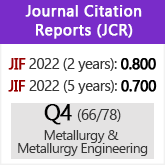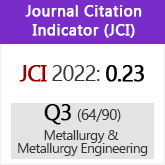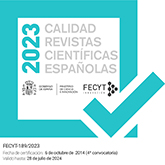Internal microporosity formation in stainless steel powders: kinetics and mechanism
DOI:
https://doi.org/10.3989/revmetalm.2002.v38.i3.399Keywords:
Powder metallurgy, Atomizing, Stainless steel powders, Microporosity, Decarburisation annealingAbstract
The internal microporosity of stainless steel powders is obtained by a technology developed in the Metallurgical Research Center (CIME) in collaboration with ISPETP, which consists of carbon enrichment of alloy during the fusion process, and after powder atomization a subsequent decarburization annealing. The internal microporosity, which can reach up to 10 volume percent of the steel particle, reduces powder density and improves powder compressibility, while costs for technology installation are also reduced. In this paper the technology for obtaining the microporosity, the mathematical models of the process, and the structural transformations undergone by stainless steel powder are shown. It is concluded that for carbon contents lower than 0.05% internal microporosity tends to disappear.
Downloads
Download data is not yet available.
Downloads
Published
2002-06-30
How to Cite
Martínez, M., Suwardjo, W., García, L., Formoso, A., & Cores, A. (2002). Internal microporosity formation in stainless steel powders: kinetics and mechanism. Revista De Metalurgia, 38(3), 173–182. https://doi.org/10.3989/revmetalm.2002.v38.i3.399
Issue
Section
Articles
License
Copyright (c) 2002 Consejo Superior de Investigaciones Científicas (CSIC)

This work is licensed under a Creative Commons Attribution 4.0 International License.
© CSIC. Manuscripts published in both the printed and online versions of this Journal are the property of Consejo Superior de Investigaciones Científicas, and quoting this source is a requirement for any partial or full reproduction.All contents of this electronic edition, except where otherwise noted, are distributed under a “Creative Commons Attribution 4.0 International” (CC BY 4.0) License. You may read here the basic information and the legal text of the license. The indication of the CC BY 4.0 License must be expressly stated in this way when necessary.
Self-archiving in repositories, personal webpages or similar, of any version other than the published by the Editor, is not allowed.

















